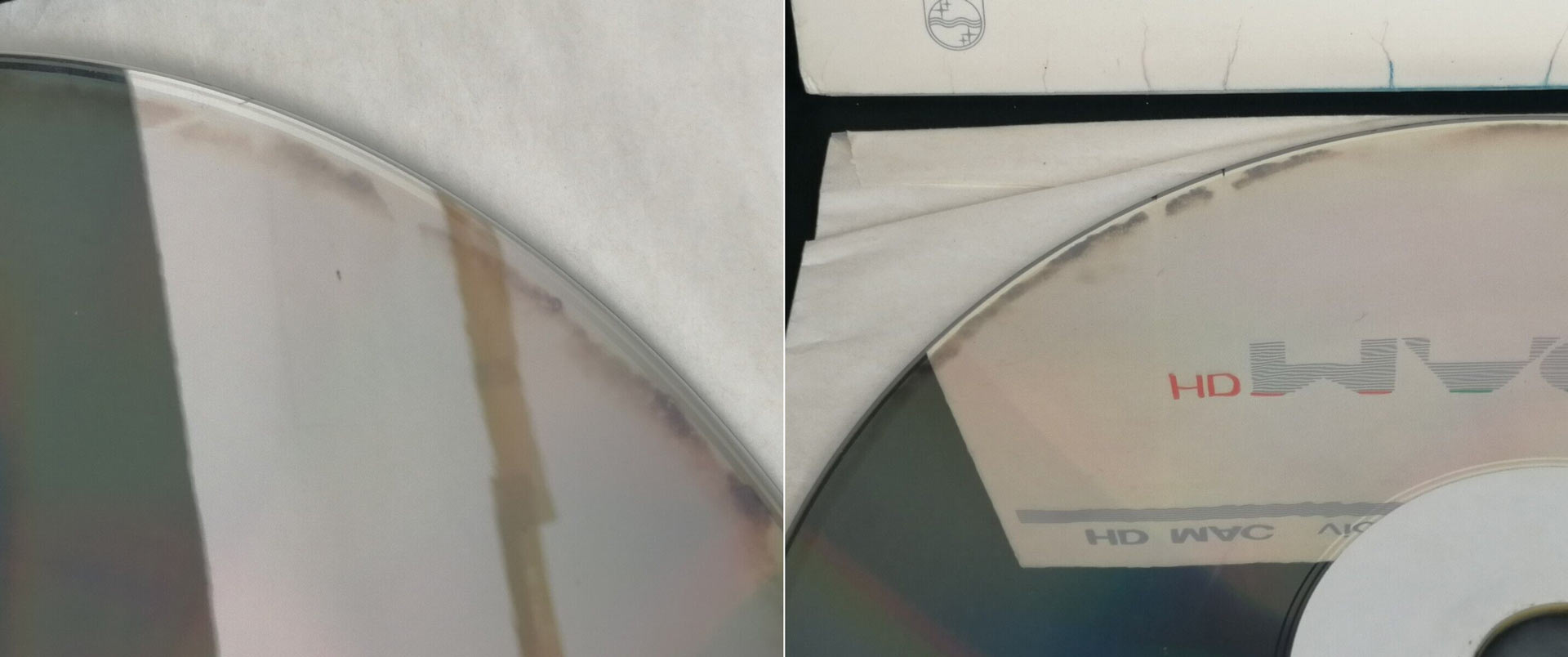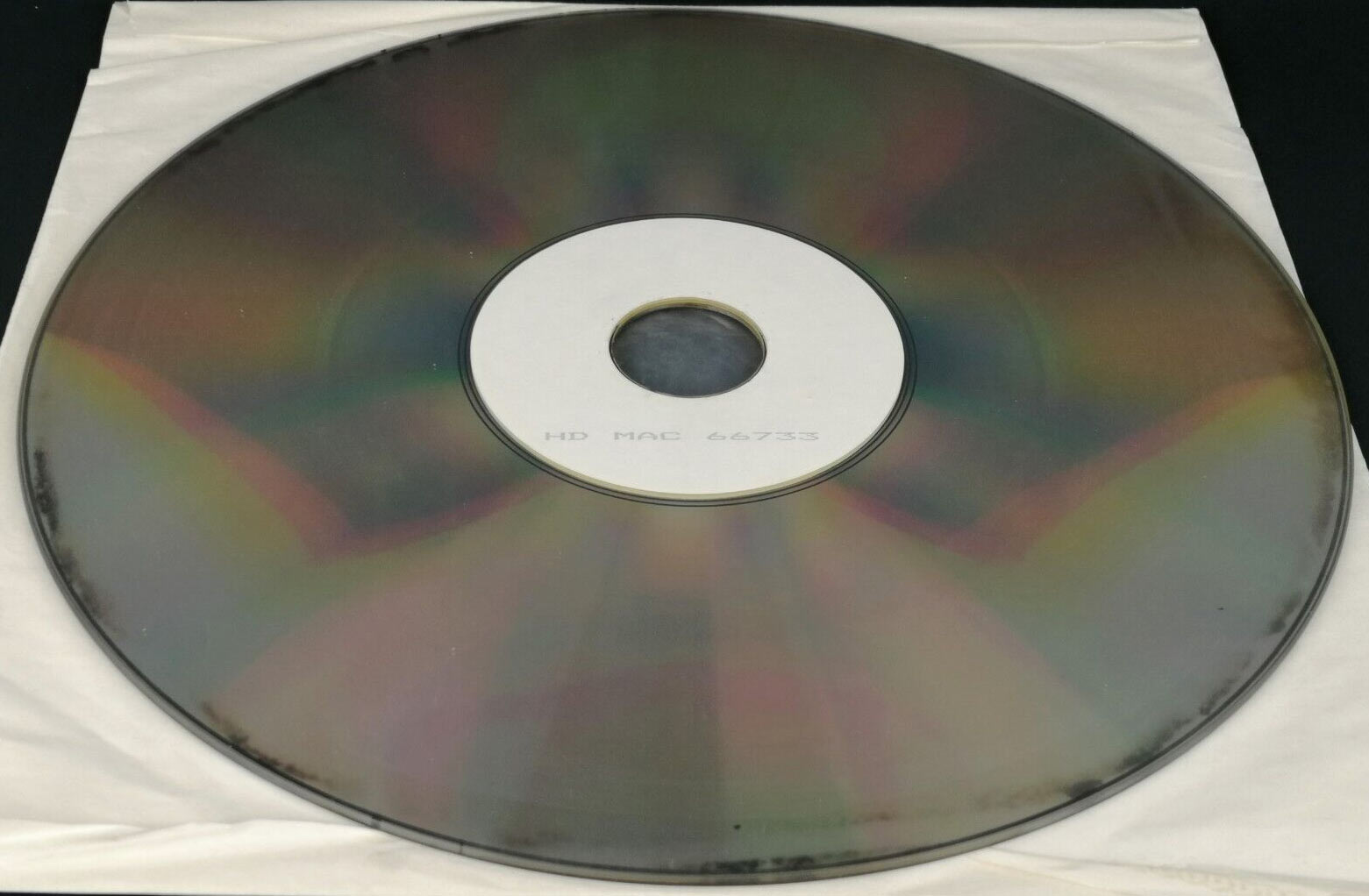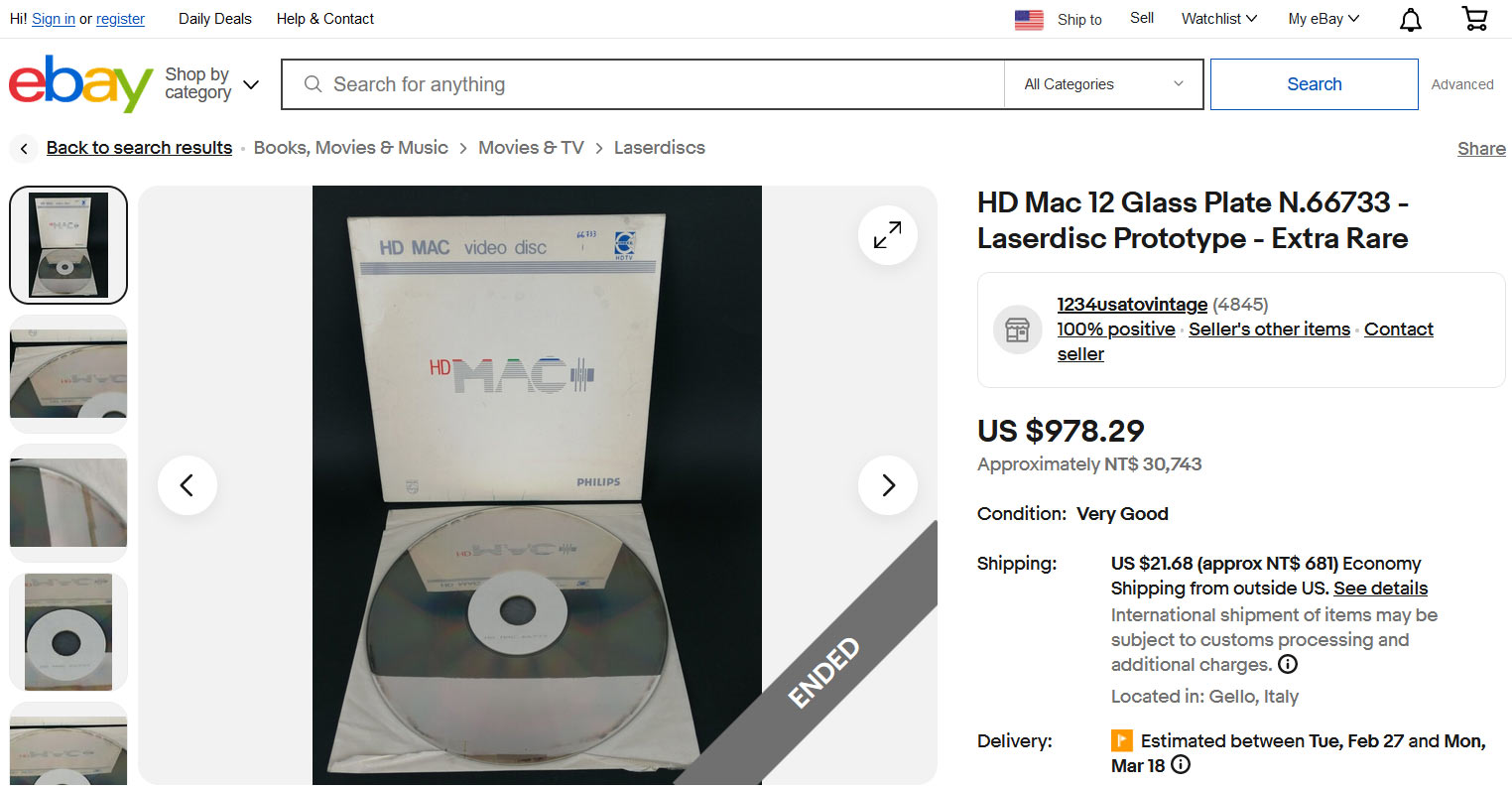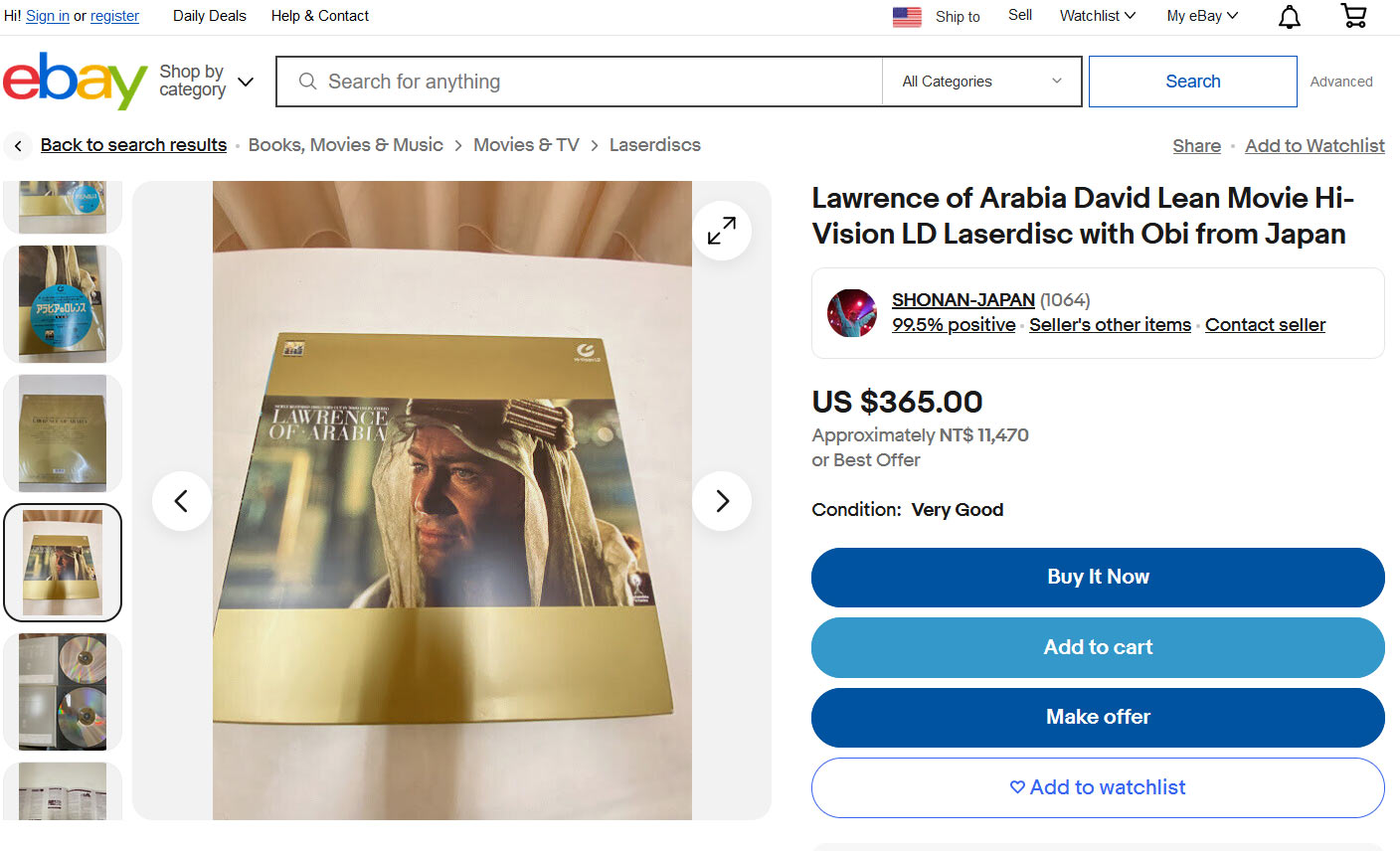Prototype LaserDisc HD media sells for $1,000 — despite disc rot and unknown contents
It isn't only retro computer prices that are getting out of hand.

A rare LaserDisc prototype has been sold on eBay for an eye-watering sum. The Philips-made product, described as an “HD Mac 12 Glass Plate N.66733 - Laserdisc Prototype - Extra Rare” sold for nearly $1,000. What is most extraordinary is that this is simply a piece of 12-inch optical media, not hardware like a player, a decoder, or any rare movie content for the platform.
The machine-translated Italian listing appears to say that this old optical disc is a very rare sample, designed to test this new HD video technology implemented in the early 1990s. According to the seller, very few such discs are available, as they were never commercially sold. Meanwhile, the condition is described as “various,” but to us, it looks poorly aged and possibly shows signs of laser rot.



Given the above description and some memory of visiting TV and hi-fi stores in the 90s, we reckon that the prototype testing disc may contain a variety of movie clips, trailers, and technical demos. The seller might not be the original owner of this disc or had access to a player, so they can’t truthfully describe its content in a sales listing.
LaserDisc HD history
Introduced in 1993, High Definition LaserDiscs were commonly known as Hi-Vision media at the time. They used a new MUSE (Multiple sUb-nyquist Sampling) encoding format to compress the audio/video stream enough to achieve decent feature lengths onto a single platter.
Japan’s NHK was the first to broadcast HD-quality TV in 1991, with up to 11 hours per day of content available to viewers by 1995. LaserDisc HD (AKA Hi-Vision, or MUSE LD) was a physical format created to hold the same quality of audio-visual content. Sony launched some of the first movie LaserDisc HD discs, including Lawrence of Arabia, Bugsy, and A League of Their Own.
Regarding quality, the LaserDisc HD format more than doubles the resolution of NTSC, moving from 525 to 1125 scan lines, and broadens the screen aspect ratio from 4:3 to the still popular 16:9.
YouTuber Techmoan made two videos about HD LaserDiscs a few years ago. If you want to know more about the format and hear his valued opinion on the quality and value, please click through. From Techmoan’s video, we have put together the approximate optical media-based video format timeline below:
Get Tom's Hardware's best news and in-depth reviews, straight to your inbox.
- 1978 - LaserDisc introduced just two years after the first VHS VCR
- 1993 - LaserDisc HD launched (took 14 years to arrive, but died in 1997)
- 1996 – DVD (1998: 1% of households, 2006: 85% of households) A cheaper format, but DVD video quality was ‘good enough’ for most before HD TVs proliferated
- 2006 – HD-DVD and Blu-Ray – first mass-market players / media
- Now – most people download or stream video entertainment
It is thought that LaserDisc HD ultimately failed as it was too expensive for the player and decoder, with the limited market size and cutting-edge components required at the time to play, decode, and watch the discs in HD.
Retro anything = ka-ching?
Nowadays, LaserDisc HD players are few and far between, with eBay samples priced at around $2,500, decoders at about $500, and a few movies that we checked were $350 each. If the market is such that people are willing to pay those prices for the hardware and media, it is probably not surprising that someone will buy a rare LaserDisc HD prototype for $1,000, even if it has laser rot.
Providing some perspective, ancient AV hardware and media isn’t that expensive compared to some of the prices retro computer component sales have achieved in recent years. For example, a year ago, we saw a rare 3dfx Voodoo 5 6000 sell for $15,000. In addition, a broken PCB from an Apple-1 computer prototype had a guide price of $500,000 yet sold for $677,196 in 2022.

Mark Tyson is a news editor at Tom's Hardware. He enjoys covering the full breadth of PC tech; from business and semiconductor design to products approaching the edge of reason.
-
bit_user Regarding the timeline...Reply
1996 – DVD (1998: 1% of households, 2006: 85% of households) A cheaper format, but DVD video quality was ‘good enough’ for most before HD TVs proliferated
The DVD format certainly had the potential to be better quality than Laserdisc. The standard definition LDs were composite video, which puts it at an inherent disadvantage. Not only that, but it's effectively an analog format. Contrast that with DVD, which is a component video digital format, and you have to try really hard to find content which cannot be mastered to look better on DVD than a corresponding LD.
That's not to say there weren't plenty of poorly mastered DVDs, in the early days. I'm sure some were even mastered from Laserdisc!
BTW, I used to follow Laserdisc discussions, for a while, and what I seem to recall is that only about 6 (certainly, not more than a dozen) MUSE titles were ever published.
ancient AV hardware and media isn’t that expensive compared to some of the prices retro computer component sales have achieved in recent years.
Eh, technological artifacts are more interesting than a bunch of paint splotched on a canvas. Especially when it's cheap & easy to get a print reproduction of art. It would be much more difficult & expensive to make a reproduction of these technological artifacts.
There's so much information contained in technological artifacts. I can imagine future technological archeologists analyzing them to try and figure out how they were made and to plot our technological progress, over the past century.
I'm not really a collector, though. So far, the only "museum piece" I've bought might turn out to be an Optane SSD.
; ) -
kurkosdr It's worth noting that MUSE/Hi-Vision and HD-MAC are two separate formats, so if this disc is indeed an HD-MAC disc as it says on the label, it's probably the only surviving example of an HD-MAC laserdisc.Reply -
bit_user Reply
I hadn't even heard of HD-MAC! I was a late-comer to the LD scene. At that point, the only discussion in LDs forum I followed, concerning hi-def, was around people trying to find the few MUSE discs and players.kurkosdr said:It's worth noting that MUSE/Hi-Vision and HD-MAC are two separate formats, -
Dr_Zathras This is not a well-researched article.Reply
The referenced YouTube video talks about the Japan-only MUSE HD video format. These HD LD players and disks are readily available on eBay, albeit at fairly high prices. The format was developed by Pioneer based on NHK's analog HD format.
This HD-MAC format was developed by Philips for the European market and never made it to commercial distribution. The only HD-MAC players were demoed at a few video shows and no disks were ever sold. As such this really is an incredibly rare disk. Mentioning it along with Pioneer's MUSE system in the way this article does suggests the author doesn't appreciate the significant differences between HD-MAC and MUSE hardware and software. -
bit_user Reply
So, is it basically the same analog signal on disc, or did the disc format markedly differ? There's some info about HD-MAC on Wikipedia, but only a passing mention of laserdiscs is made:Dr_Zathras said:This is not a well-researched article.
The referenced YouTube video talks about the Japan-only MUSE HD video format. These HD LD players and disks are readily available on eBay, albeit at fairly high prices. The format was developed by Pioneer based on NHK's analog HD format.
This HD-MAC format was developed by Philips for the European market and never made it to commercial distribution. The only HD-MAC players were demoed at a few video shows and no disks were ever sold.
https://en.wikipedia.org/wiki/HD-MAC -
Dr_Zathras Reply
The video signals for HD-MAC and MUSE are markedly different. They're both interlaced analog formats, but HD-MAC uses 1250 lines at 50 fields/second, while MUSE is 1080 lines at 60 fields/second. In this respect they mirror the previous generation European PAL (625/50Hz) and US/Japan NTSC (525/60Hz) formats as requiring entirely different decoding circuitry.bit_user said:So, is it basically the same analog signal on disc, or did the disc format markedly differ? There's some info about HD-MAC on Wikipedia, but only a passing mention of laserdiscs is made:
https://en.wikipedia.org/wiki/HD-MAC
That's what makes this article so misleading as the author talks about MUSE disks when the eBay sale was for an HD-MAC disk. Yes, they both use 12" optical disks for analog data storage, but that's where the similarity ends. It would be like seeing a PAL ED-Beta VCR for sale and wondering why it went for so much when NTSC ED-Beta VCRs are plentiful. But that's a whole other topic.
HD-MAC and MUSE are the ultimate, but end-of-the-line results of analog video research. They were both abandoned when it became clear the future of audio and video is digital. HD LaserVision didn't fail due to it being too expensive, as this article suggests. Pioneer simply stopped manufacturing the players and pressing the disks when all work on everything using MUSE technology came to an end. -
bit_user Reply
Sorry, I meant was the on-disc format of HD-MAC the same as the wire format? I read where you already stated HD-MAC and MUSE discs were different.Dr_Zathras said:The video signals for HD-MAC and MUSE are markedly different.
What's funny about this is that HD-laserdiscs got killed by... DVDs? Because, it seems they got abandoned when Blu-Ray/HD-DVD were still almost a decade away from reaching the market!Dr_Zathras said:HD-MAC and MUSE are the ultimate, but end-of-the-line results of analog video research. They were both abandoned when it became clear the future of audio and video is digital. HD LaserVision didn't fail due to it being too expensive, as this article suggests. Pioneer simply stopped manufacturing the players and pressing the disks when all work on everything using MUSE technology came to an end.
In the interim, the only home video HD format I'm aware of was DVHS. For the most part, I think people just used DVHS to record over-the-air HD broadcasts, in the early 2000's. You could buy a handful of commercial titles on DVHS - probably a lot more than the number of titles available on MUSE discs - but still, not many. -
kurkosdr Reply
Nobody knows what an HD-MAC Laserdisc is (aka if it's the same signal as the HD-MAC satellite transmissions) because the format wasn't available to the public back in the day so people could analyse it, but I guess this adds to the mystery and desirability of the item.bit_user said:So, is it basically the same analog signal on disc, or did the disc format markedly differ? There's some info about HD-MAC on Wikipedia, but only a passing mention of laserdiscs is made:
https://en.wikipedia.org/wiki/HD-MAC
BTW it's worth noting that both HD-MAC and MUSE were a weird kind of analog, using a technique called "dot-interlaced" where the signal was interlaced in both dimensions. It started off as digital signal, the pixel grid was then notionally divided to 2x2 squares, and only one pixel of each 2x2 square was sampled in each pass (in a checkerboard pattern). This means you needed 4 passes to make a complete picture (instead of 2 that normal interlaced needs). This resulted in checkerboard artifacts (instead of the combing artifacts of normal interlaced), though global motion compensation prevented this from happening during full pans. Also, HD-MAC's innovation compared to MUSE was that you could choose to have 1/4 framerate (aka 12.5p) to have progressive scan or 1/2 framerate (aka 25i) to have normal interlaced scan, switchable on the fly. -
Dr_Zathras Replykurkosdr said:Nobody knows what an HD-MAC Laserdisc is (if it's the same signal as the satellite HD-MAC transmissions), because it wasn't available to the public back in the day, but I guess this adds to the mystery and desirability.
The engineering archives at Philips NV will hold this information, assuming they still exist. The prototype HD-MAC players may still be in storage somewhere, and some of the original engineers are almost certainly still with us. video99.co.uk has an excellent YouTube interview with Rudolf Drabek who worked on the N1500, N1700 and V2000 video cassette formats. If we can speak to an N1500 engineer, we can surely still find an HD-MAC Laserdisk expert given its much more recent history.
Even without direct access to the prototype player or engineers, it might be possible to reverse engineer this format by reading and decoding the FM waveform (remember, this is an analog format) directly off the disk using a variant of the Domesday Duplicator and the HD-MAC disk that began this thread.. We might need a shorter wavelength laser (as used by the Japanese MUSE players) if the format used a higher data density, but this doesn't strike me as an impossible task. In fact, it would make an fascinating intellectual challenge. -
bit_user Reply
What I like about these ancient formats is that technological limitations of the era meant they had only so many ways to do things. I feel like it should be pretty straight forward to narrow down essentially what they did, but there might be a few tricks they devised for better decoding that could be non-obvious.Dr_Zathras said:Even without direct access to the prototype player or engineers, it might be possible to reverse engineer this format by reading and decoding the FM waveform (remember, this is an analog format) directly off the disk
The what?Dr_Zathras said:using a variant of the Domesday Duplicator
This sort of reminds me of finding a thread on some internet forum or another, where someone claimed to have reverse-engineered the 90's era HDCD encoding format, by Pacific Microsonics (who were subsequently acquired by Microsoft). He initially published a decoder, but Microsoft's lawyers caught wind of it and sent him a Cease and Desist letter.Dr_Zathras said:this doesn't strike me as an impossible task. In fact, it would make an fascinating intellectual challenge.
I always thought it would be neat to build a LD player with today's technology. I've long been intrigued by the challenge of building the ultimate composite video decoder or the best deinterlacer. Perhaps deep learning is just the technology needed to solve those stubborn corner cases.
It's mad how LDs used composite video, BTW. From what I've heard, virtually no other media format did such a thing!

